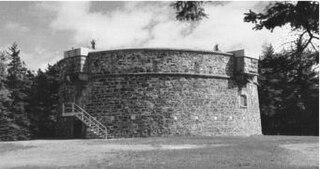
Martello towers, sometimes known simply as Martellos, are small defensive forts that were built across the British Empire during the 19th century, from the time of the French Revolutionary Wars onwards. Most were coastal forts.

Eastbourne Redoubt is a circular coastal defence fort at Eastbourne, East Sussex, on the south coast of England. It was built in 1805 as part of the British anti-invasion preparations during the Napoleonic Wars. The building is now owned by the local authority and is open to the public.

Fort Grey, colloquially known as the "cup and saucer", is a Martello tower located on a tidal rock in Rocquaine Bay in Saint Peter, Guernsey on the west coast of the island.

A watchtower or watch tower is a type of fortification used in many parts of the world. It differs from a regular tower in that its primary use is military and from a turret in that it is usually a freestanding structure. Its main purpose is to provide a high, safe place from which a sentinel or guard may observe the surrounding area. In some cases, non-military towers, such as religious towers, may also be used as watchtowers.

Jaywick Martello Tower is a renovated Martello tower at Jaywick, 2.7 miles (4.3 km) south-west of Clacton-on-Sea, Essex. It now functions as an arts, heritage and community venue.
Jersey is a heavily fortified island with coastal fortifications that date to the English Civil War, the Napoleonic Wars, and Nazi Germany's occupation of the Channel Islands. The fortifications include castles, forts, towers, Martello towers, artillery batteries, and seawalls. Not infrequently, fortifications from one period are built on the site of earlier fortifications, or very near them, geography having remained the same even when firepower increased.
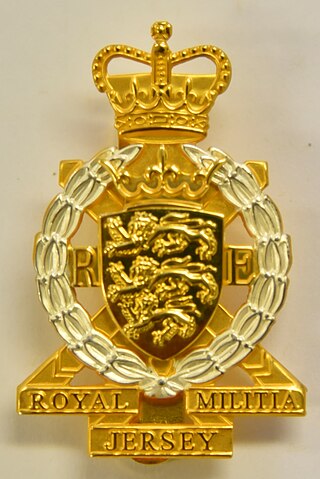
Formed in 1337, the Royal Militia of the Island of Jersey can claim to be the oldest sub-unit of the British Army, although, because it is not a regiment, and was disbanded for decades in the late 20th century, it is not the most senior.

The Invasion of Jersey was a failed French attack on British-held Jersey in 1779, during the American Revolutionary War.

Battery Lothringen was a World War II coastal artillery battery in Saint Brélade, Jersey, named after the SMS Lothringen, and constructed by Organisation Todt for the Wehrmacht during the Occupation of the Channel Islands. The first installations were completed in 1941, around the same time as the completion of the nearby Battery Moltke, in St. Ouen.

The Bréhon Tower is accessible only by boat and sits on Bréhon Rock, an island in the Little Russell channel about 1.5 km northeast of St Peter Port, Guernsey, between the port and the islands of Herm and Jethou. Thomas Charles de Putron (1806–1869) built the oval tower of granite from Herm, completing the work in 1857.

Fort Saumarez is a Martello tower in Saint Peter, Guernsey, on a headland that forms the northern tip of L'Erée and extends to the Lihou causeway.

Fort Hommet is a fortification on Vazon Bay headland in Castel, Guernsey. It is built on the site of fortifications that date back to 1680, and consists of a Martello tower from 1804, later additions during the Victorian Era, and bunkers and casemates that the Germans constructed during World War II.

The British built 15 Guernsey loophole towers at various points along the coast of Guernsey between August 1778 and March 1779 to deter possible French attacks after France had declared itself an ally of the Americans in the American Revolutionary War. Towards the start of the Napoleonic Wars several towers received additional reinforcement in the form of batteries at their bases. Today, 12 towers still survive, three having been destroyed at different times. Two of the survivors, Petit Bôt and Rousse, contain interpretive exhibits that the public may examine.

The Channel Islands Occupation Society (CIOS) is a voluntary organisation that seeks to study all aspects of the German occupation of the Channel Islands and to raise awareness and educate the public about the occupation during the Second World War. There are two branches, one in Jersey and the other in Guernsey, that take turns in publishing the Channel Islands Occupation Review. The CIOS manages many German fortifications and archives on both islands.

Battery Moltke is an uncompleted World War II former coastal artillery battery in St Ouen in north-west Jersey. It was constructed by Organisation Todt for the Wehrmacht during the occupation of the Channel Islands.

The Prince of Wales Tower is the oldest martello tower in North America and is located in Point Pleasant Park, Halifax Regional Municipality, Nova Scotia, Canada. It was built in 1796 by Captain James Straton and was used as a redoubt and a powder magazine. Restored, it was designated a National Historic Site of Canada in 1943.
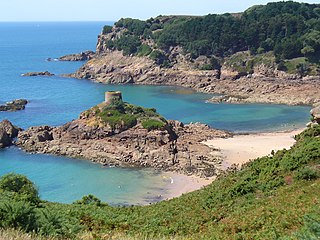
Portelet Tower, Jersey, is a Martello tower that the British built in 1808 on the tidal island L'Île au Guerdain in Portelet Bay in the parish of Saint Brélade, Jersey. The site is often referred to as Janvrin's tower or Janvrin's Tomb. The site is accessible at low tide.
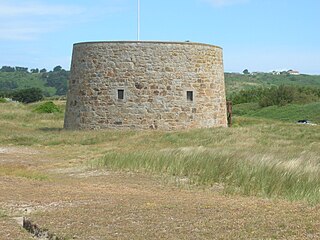
Kempt Tower, in La Grande Cueillette, Saint Ouen, Jersey, is also known as Saint Ouen No. 2 and La Grôsse Tou in Jèrriais, and is a Martello tower that the British completed in 1834. It is named for Sir James Kempt, the Master-General of the Ordnance from 1830 to 1834. While governor of Canada, Kempt was involved in the planning for the use of Martello towers to protect the colony. Currently, Kempt Tower serves as the interpretation centre for Les Mielles conservation area.

Victoria Tower, Jersey, is a Martello tower that the British completed in 1837 and named after Queen Victoria, who succeeded to the Throne in that year. The tower sits on Le Mont Nicholas in Saint Martin, and its builders placed it there to impede an enemy from siting guns there with which to bombard Mont Orgueil. Currently, the National Trust for Jersey administers the tower.
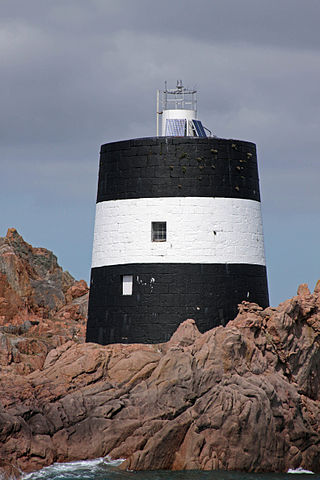
La Tour de Vinde is a Martello tower that the British erected between 1808 and 1810 to command the approaches to St Aubin's Bay, Jersey. The tower stands at the foot of the cliffs of Noirmont Point, in the Vingtaine de Noirmont in the Parish of Saint Brélade. During the occupation of the Channel Islands in World War II, the Germans erected Battery Lothringen on the top of Noirmont Point. The site of the tower is accessible at low tide by foot, though the tower itself is closed to the public.



















